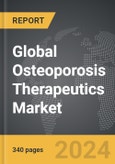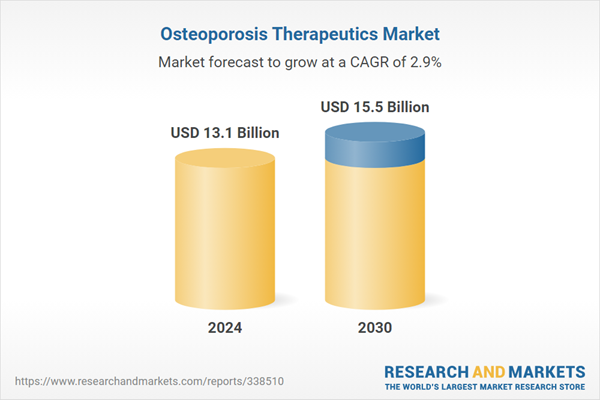Global Osteoporosis Therapeutics Market - Key Trends & Drivers Summarized
Osteoporosis is a chronic condition characterized by a decrease in bone density and an increased risk of fractures. Therapeutics for osteoporosis aim to strengthen bone, minimize bone loss, and reduce the risk of fracture, primarily through the use of pharmacological treatments. These treatments include bisphosphonates, which inhibit bone resorption; selective estrogen receptor modulators (SERMs), which replicate estrogen's beneficial effects on bone density without some of the hormone's potential risks; and parathyroid hormone-related proteins, which can stimulate bone growth. More recently, treatments have included biological agents such as denosumab, which targets and inhibits a key protein involved in bone resorption. The choice of treatment depends on various factors, including the patient's specific risk factors, the severity of bone density loss, and the presence of other medical conditions. Additionally, calcium and vitamin D supplements are often recommended alongside these treatments to enhance bone strength, as both are critical components of bone health.In addition to pharmacotherapy, lifestyle modifications play a crucial role in managing and preventing osteoporosis. Regular weight-bearing and muscle-strengthening exercises are recommended to help improve bone density and strength. Moreover, dietary adjustments to ensure adequate intake of bone-healthy nutrients, and lifestyle changes such as smoking cessation and reducing alcohol consumption, can also have a positive impact on bone health. The role of technology in osteoporosis therapeutics has also been expanding, with developments in bone densitometry improving the accuracy and ease of monitoring bone density. Telemedicine and mobile health applications provide patients and healthcare providers with better tools for managing the disease, improving medication adherence, and tracking patient progress with lifestyle interventions. These technological advancements support a more proactive and personalized approach to osteoporosis management, aligning treatment and preventive strategies more closely with individual patient needs.
The growth in the osteoporosis therapeutics market is driven by several factors, including the increasing global elderly population, rising prevalence of osteoporosis, advancements in therapeutic options, and growing awareness of the disease. As the global population ages, the incidence of osteoporosis and resultant fractures is expected to rise, driving demand for effective treatment solutions. Advances in pharmaceuticals and biotechnology have led to the development of newer, more effective drugs with fewer side effects, enhancing patient outcomes and compliance. Additionally, there is a growing emphasis on early diagnosis and prevention, supported by improvements in diagnostic technologies and screening practices, which further stimulate the market. Increased public and medical community awareness about osteoporosis and its impact on quality of life has also helped to drive the market, as has the expansion of healthcare infrastructure and insurance coverage in emerging economies. These dynamics suggest that the osteoporosis therapeutics market will continue to expand, driven by both an urgent need for effective management of osteoporosis and ongoing improvements in therapeutic practices and products.
Report Scope
The report analyzes the Osteoporosis Therapeutics market, presented in terms of market value (USD). The analysis covers the key segments and geographic regions outlined below.- Segments: Drug Class (Bisphosphonates, Parathyroid Hormone Therapy, Calcitonin, Selective Estrogen Inhibitors Modulator (SERM), and Rank Ligand Inhibitors); Route of Administration (Oral, Injectables, and Other Routes of Administration).
- Geographic Regions/Countries: World; United States; Canada; Japan; China; Europe (France; Germany; Italy; United Kingdom; Spain; Russia; and Rest of Europe); Asia-Pacific (Australia; India; South Korea; and Rest of Asia-Pacific); Latin America (Argentina; Brazil; Mexico; and Rest of Latin America); Middle East (Iran; Israel; Saudi Arabia; United Arab Emirates; and Rest of Middle East); and Africa.
Key Insights:
- Market Growth: Understand the significant growth trajectory of the Bisphosphonates segment, which is expected to reach US$8.1 Billion by 2030 with a CAGR of 3.1%. The Parathyroid Hormone Therapy segment is also set to grow at 2.4% CAGR over the analysis period.
- Regional Analysis: Gain insights into the U.S. market, valued at $5.3 Billion in 2024, and China, forecasted to grow at an impressive 5.3% CAGR to reach $900.1 Million by 2030. Discover growth trends in other key regions, including Japan, Canada, Germany, and the Asia-Pacific.
Why You Should Buy This Report:
- Detailed Market Analysis: Access a thorough analysis of the Global Osteoporosis Therapeutics Market, covering all major geographic regions and market segments.
- Competitive Insights: Get an overview of the competitive landscape, including the market presence of major players across different geographies.
- Future Trends and Drivers: Understand the key trends and drivers shaping the future of the Global Osteoporosis Therapeutics Market.
- Actionable Insights: Benefit from actionable insights that can help you identify new revenue opportunities and make strategic business decisions.
Key Questions Answered:
- How is the Global Osteoporosis Therapeutics Market expected to evolve by 2030?
- What are the main drivers and restraints affecting the market?
- Which market segments will grow the most over the forecast period?
- How will market shares for different regions and segments change by 2030?
- Who are the leading players in the market, and what are their prospects?
Report Features:
- Comprehensive Market Data: Independent analysis of annual sales and market forecasts in US$ Million from 2024 to 2030.
- In-Depth Regional Analysis: Detailed insights into key markets, including the U.S., China, Japan, Canada, Europe, Asia-Pacific, Latin America, Middle East, and Africa.
- Company Profiles: Coverage of players such as Amgen, Inc., Asahi Kasei Pharma Corporation, Bone Biologics Corp., Novartis AG, Pfizer, Inc. and more.
- Complimentary Updates: Receive free report updates for one year to keep you informed of the latest market developments.
Some of the 53 companies featured in this Osteoporosis Therapeutics market report include:
- Amgen, Inc.
- Asahi Kasei Pharma Corporation
- Bone Biologics Corp.
- Novartis AG
- Pfizer, Inc.
- Taisho Pharmaceutical Co., Ltd.
- Teijin Ltd.
- Transcenta
- Uni-Bio Science Group Ltd.
- Viking Therapeutics
- Zydus Lifesciences Limited
This edition integrates the latest global trade and economic shifts into comprehensive market analysis. Key updates include:
- Tariff and Trade Impact: Insights into global tariff negotiations across 180+ countries, with analysis of supply chain turbulence, sourcing disruptions, and geographic realignment. Special focus on 2025 as a pivotal year for trade tensions, including updated perspectives on the Trump-era tariffs.
- Adjusted Forecasts and Analytics: Revised global and regional market forecasts through 2030, incorporating tariff effects, economic uncertainty, and structural changes in globalization. Includes historical analysis from 2015 to 2023.
- Strategic Market Dynamics: Evaluation of revised market prospects, regional outlooks, and key economic indicators such as population and urbanization trends.
- Innovation & Technology Trends: Latest developments in product and process innovation, emerging technologies, and key industry drivers shaping the competitive landscape.
- Competitive Intelligence: Updated global market share estimates for 2025, competitive positioning of major players (Strong/Active/Niche/Trivial), and refined focus on leading global brands and core players.
- Expert Insight & Commentary: Strategic analysis from economists, trade experts, and domain specialists to contextualize market shifts and identify emerging opportunities.
Table of Contents
Companies Mentioned (Partial List)
A selection of companies mentioned in this report includes, but is not limited to:
- Amgen, Inc.
- Asahi Kasei Pharma Corporation
- Bone Biologics Corp.
- Novartis AG
- Pfizer, Inc.
- Taisho Pharmaceutical Co., Ltd.
- Teijin Ltd.
- Transcenta
- Uni-Bio Science Group Ltd.
- Viking Therapeutics
- Zydus Lifesciences Limited
Table Information
| Report Attribute | Details |
|---|---|
| No. of Pages | 340 |
| Published | December 2025 |
| Forecast Period | 2024 - 2030 |
| Estimated Market Value ( USD | $ 13.1 Billion |
| Forecasted Market Value ( USD | $ 15.5 Billion |
| Compound Annual Growth Rate | 2.9% |
| Regions Covered | Global |









